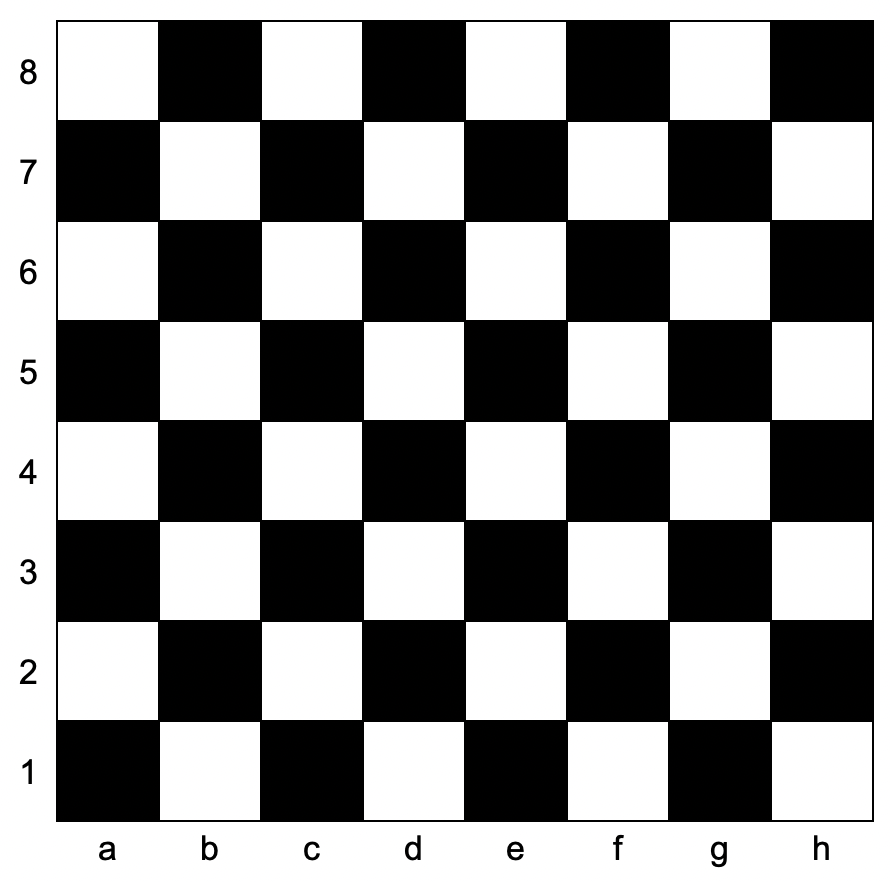- {x}
- Implement Trie II (Prefix Tree)
- Number of Different Integers in a String
- Minimum Number of Operations to Reinitialize a Permutation
- Evaluate the Bracket Pairs of a String
- Maximize Number of Nice Divisors
- Ad-Free Sessions
- Minimum Path Cost in a Hidden Grid
- Find Interview Candidates
- Determine Color of a Chessboard Square
- Sentence Similarity III
- Count Nice Pairs in an Array
- Maximum Number of Groups Getting Fresh Donuts
- Truncate Sentence
- Finding the Users Active Minutes
- Minimum Absolute Sum Difference
- Number of Different Subsequences GCDs
- Maximum Number of Accepted Invitations
- Read More...

Determine Color of a Chessboard Square
You are given coordinates, a string that represents the coordinates of a square of the chessboard. Below is a chessboard for your reference.

Return true if the square is white, and false if the square is black.
The coordinate will always represent a valid chessboard square. The coordinate will always have the letter first, and the number second.
Example 1:
Input: coordinates = "a1" Output: false Explanation: From the chessboard above, the square with coordinates "a1" is black, so return false.
Example 2:
Input: coordinates = "h3" Output: true Explanation: From the chessboard above, the square with coordinates "h3" is white, so return true.
Example 3:
Input: coordinates = "c7" Output: false
Constraints:
coordinates.length == 2'a' <= coordinates[0] <= 'h''1' <= coordinates[1] <= '8'
Solution Explanation: Determine Color of a Chessboard Square
This problem asks to determine whether a given chessboard square is white or black based on its coordinates.
Understanding the Pattern:
A chessboard has an alternating pattern of black and white squares. Notice that:
- Squares with coordinates where the sum of the row and column numbers is even are black.
- Squares with coordinates where the sum of the row and column numbers is odd are white.
Algorithm:
-
Extract Coordinates: The input
coordinatesstring contains the column letter (a-h) and the row number (1-8). -
Convert to Numbers: Convert the column letter to its corresponding numerical value (a=1, b=2, ..., h=8). The row number is already numerical.
-
Calculate the Sum: Add the numerical representations of the column and row.
-
Check Parity: Check if the sum is even or odd. If odd, the square is white; if even, it's black.
Time and Space Complexity:
- Time Complexity: O(1). The operations performed are constant time regardless of the input size (since the input is always a two-character string).
- Space Complexity: O(1). The algorithm uses a constant amount of extra space.
Code Implementation (Python):
class Solution:
def squareIsWhite(self, coordinates: str) -> bool:
col = ord(coordinates[0]) - ord('a') + 1 # Convert column letter to number
row = int(coordinates[1]) # Row number is already an integer
return (col + row) % 2 != 0 # Check if sum is odd (white)Code Implementation (Java):
class Solution {
public boolean squareIsWhite(String coordinates) {
int col = coordinates.charAt(0) - 'a' + 1;
int row = coordinates.charAt(1) - '0';
return (col + row) % 2 != 0;
}
}Code Implementation (C++):
class Solution {
public:
bool squareIsWhite(string coordinates) {
int col = coordinates[0] - 'a' + 1;
int row = coordinates[1] - '0';
return (col + row) % 2 != 0;
}
};Other Languages (Similar Approach): The core logic remains consistent across different programming languages. The only variation lies in the syntax and data type handling. For instance, character-to-integer conversion might slightly vary. The provided solution section in the original prompt demonstrates this adaptability across several other languages.
Optimization Note: The % 2 operation is efficient, directly checking for oddness. There's no significant performance optimization to be gained here.